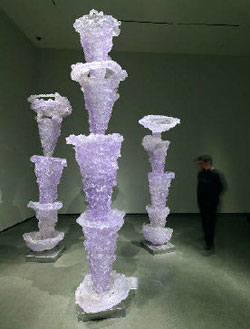
 Sculpture News at SculptSite.com
Sculpture News at SculptSite.com
Lynda Benglis Sculpture |
 The Graces, a 2003-05 glass sculpture by Lynda Benglis, is part of an exhibit of Benglis's work at the RISD Museum. RISD Museum / Erik Gould |
| projo.com By Bill Van Siclen Lynda Benglis: Sculptor on the edgeSculptor Lynda Benglis first made waves in late 1960s with a series of "floor paintings" - works she created by pouring batches of brightly tinted liquid rubber on the floor, then allowing them to dry. The results, which looked a bit like Technicolor lava flows, helped free American art from the spare, less-is-more style of the era's then-dominant art movement: Minimalism. But it was another work that brought Benglis the kind of notoriety normally reserved for bad-boy artists like Picasso (he of the fractured female nudes) and Marcel Duchamp (the puckish Frenchman who once outraged viewers by exhibiting a store-bought urinal as art). In 1974, Benglis paid $3,000 to take out an ad in Artforum, a prominent art-world journal. There was no text, just a full-page color photograph of the statuesque Benglis posing stark naked, except for two items: a pair of mirrored aviator's sunglasses and giant latex marital aid. As you might expect, the Artforum ad caused a sensation, even among Benglis's fellow artists. To some, it was a welcome challenge to the art world's male-centered power structure - a statement that male artists weren't the only ones who could take a walk on the wild side. To others, including several Artforum staffers who resigned in protest, it was demeaning and degrading. Sadly but perhaps inevitably, the intensity of that era is largely missing from "Lynda Benglis," a traveling survey of Benglis's work that opened Friday at the RISD Museum. Organized by the Irish Museum of Modern Art in conjunction with several other museums (including the RISD Museum and New York's New Museum), the show does a good job of tracing Benglis's career, beginning with the poured-rubber "floor paintings" from the late '60s and early '70s and continuing through her more recent experiments with metal, glass and latex. There's also a healthy sampling of works from two of Benglis's best known series - the so-called "Knot" sculptures, in which tubular lengths of fabric and metal are tied and twisted into knot-like shapes, and a group of "pleated" metal sculptures that evoke everything from billowing clouds to ancient Greek statues. Another highlight is "Phantom," a rarely seen 1971 work in which Benglis poured fluorescent polyurethane over a series of rounded wire-mesh armatures. Installed in a special gallery that cycles from light to dark and back to light again, "Phantom" suggests a kind of magical cavern, complete with luminous underground streams and glow-in-the dark stalactites and stalagmites. And what of the infamous Artforum ad? Viewers will find it tucked away in a small display case on one side of the museum's main Chace Center gallery. That's probably a good thing, especially since the sheer outrageousness and sexual bravado of Benglis's pose still has the power to shock, even 40 years later. Unfortunately, it also tends to mute some of the buzz - both pro and con - that once swirled around the work of Benglis and other so-called Post-Minimalist artists such as Eva Hesse, Bruce Nauman and Robert Morris. Where Minimalism was cool and cerebral, Post-Minimalism strove to be dramatic and emotional. Where Minimalist artists favored solid materials such as wood and metal, Post-Minimalism reveled in softer, more "feminine" materials such as rubber, wax and fabric. Where Minimalism all but outlawed body references, Post-Minimalism happily embraced them - X-rated parts and all. Not surprisingly, this was also the heyday of performance art, as artists began using their own bodies to explore themes of gender, identity and sexuality. Wandering through the two large galleries that RISD has devoted to the exhibit, it's clear that Benglis was at the forefront of many of these developments. Her poured-rubber "floor paintings," for example, take Jackson Pollock's famous drip method and transform it into something far more tactile and sculptural. The result is both an act of homage and a playful bit of artistic sabotage. Look closely at some of the "Knot" sculptures, meanwhile, and you'll find a material that Minimalist masters like Sol Lewitt and Donald Judd would never have used: glitter. At the same time, there's a traditional, even classical, side to Benglis's work that belies her bad-girl reputation. Perhaps the most notable example is "Primary Structures," a 1975 installation that features a series of pint-size classical columns (including one topped with a tiny Porsche roadster - a reference to the car that Benglis was driving at the time). References to classical art can also be found in "Panhard," a 1989 work that looks a bit like an abstract version of a winged Victory, and "The Three Graces" (2003), a group of striking glass sculptures that takes its name from Greek mythology. (Then again, Benglis's interest with classical art may not be that surprising: Born in Lake Charles, La., in 1941, she grew up in a Greek-American family that clearly relished its Old World roots. Indeed, the show's catalog includes several photographs of the young Benglis vacationing in Greece accompanied by various family members.) "Lynda Benglis" runs through Jan. 9 at the RISD Museum, 224 Benefit St. in Providence. |
 Thank you Bill Van Siclen, a great read. Outrageous at times, yet talented artist/sculptor. "The Graces" are peaceful to look at, you don't forget them, cool, yet friendly. |
More Sculpture News ....
Submit your SCULPTURE NEWS.
It's easy, just send us an e-mail
(click on Submit News in the left menu) with your pertinent information along with images, we'll take care of the rest. Sculpture makes our world a much better place in so many ways!
SculptSite.com, along with Sculptors and their creative genius all helping to bring the beauty and message of Sculpture to a hurried world.

